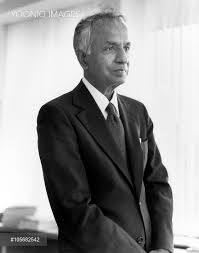 “The black holes of nature are the most perfect macroscopic objects there are in the universe: the only elements in their construction are our concepts of space and time.”
“The black holes of nature are the most perfect macroscopic objects there are in the universe: the only elements in their construction are our concepts of space and time.”
Born in Lahore, India (now in Pakistan), Subrahmanyan Chandrasekhar was an internationally recognized astrophysicist who won the Nobel Prize in 1983 for key discoveries in Physics. Incidentally, he is also the nephew of C.V. Raman, a Nobel Prize winner in 1930. He was schooled at the Presidency College at the University of Madras and Trinity College, Cambridge. His father was a government officer and his mother was involved in translating literary works to Tamil. Till the age of twelve, he was schooled at home.
His studies that received worldwide acclaim included “The Chandrasekhar Effect” he proved that it is not possible for a white dwarf star to remain stable in case its mass becomes more than 1.44 times the mass of the sun, as it is supported only by a degenerate gas of electrons. This study incorporated the study of relativity by Einstein. Some of his other studies include the black hole, convection, star, and radiation. Besides, he was also awarded the Copley Medical in 1984. In fact, he was awarded a scholarship at the University of Cambridge, recognizing his potential in physics. In 1933, he moved to Cambridge, wherein he completed his Ph. D. degree and decided to continue his fellowship for further four years.
However, little is known that Chandrasekar’s theories won a lot of opposition from top scientists at the university, although they are today believed to be correct. Hence, after completion of his tenure at Cambridge, he moved on to the University of Chicago for further research related to white dwarf stars and associated studies. Over the period, he published a lot of ground-breaking research across various astrophysics subjects. He continued his association with the University of Chicago, working as a professor till 1980. His accomplishments are innumerous, some of which are listed below:
- 1948, Cambridge University Adams Prize
- 1953, The Royal Astronomical Society Gold Medal
- 1957, Rumford Prize of the American Academy of Arts and Sciences
- 1966, National Medal of Science
- 1968, Padma Vibhushan
- 1983, Nobel Prize in Physics
- 1984, Royal Society Copley Medal
He wrote the book Newton’s Principia for the Common Reader just before his death in 1995, caused by a heart attack. There is an observatory named under him “Chandra X-ray observatory”. Even today, he is remembered as one of the greatest astrophysicists of all time. We still celebrate his contribution to the field of science.
“Science is a perception of the world around us. Science is a place where what you find in nature pleases you.”
Pride Score – 5/5
A super-impressive 9/10 Notable Brahmin Score.